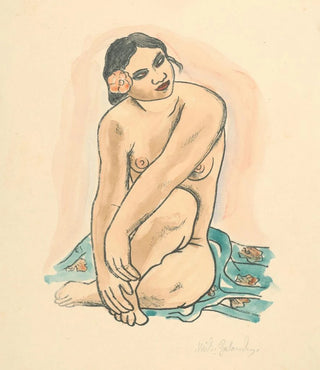Art print | A girl from Tahiti - Mikuláš Galanda


View from behind

Frame (optional)
"Reproduction Une fille de Tahiti" by Mikuláš Galanda is a captivating artwork that evokes distant landscapes, a rich culture, and profound emotions. Through this piece, the artist manages to capture the very essence of Tahitian beauty, while incorporating a personal touch that makes his interpretation unique. The scene depicts a young woman, a symbol of island beauty, surrounded by lush nature, where every detail seems to tell a story. This work is not limited to a simple representation; it invites the viewer to immerse themselves in a universe where time appears suspended, where serenity and harmony reign supreme.
Style and uniqueness of the work
Galanda's style is distinguished by its bold use of color and light. In "Reproduction Une fille de Tahiti," vibrant hues evoke the warmth of the sun and the richness of local flora. The artist skillfully plays with shadows and highlights, creating a striking contrast that emphasizes the beauty of the subject. The composition, though simple, is highly effective; it guides the viewer's gaze toward the face of the young woman, where an expression of calm and contemplation is evident. Natural elements, such as exotic flowers and foliage, are not mere backgrounds but active protagonists that contribute to the overall harmony. This artwork is a celebration of life and nature, an invitation to daydream and escape.
The artist and his influence
Mikuláš Galanda, a Slovak artist of the 20th century, is recognized for his ability to fuse different artistic influences. His academic training and travels around the world enriched his approach to painting. Drawing inspiration from Impressionist and Post-Impressionist movements, he developed a personal style that resonates with themes of nature and humanity. "Reproduction Une fille de Tahiti" reflects this quest for authenticity and beauty, where each brushstroke bears witness to his admiration for the cultures he encountered. Galanda successfully built a bridge between the East and the West, and

Matte finish

View from behind

Frame (optional)
"Reproduction Une fille de Tahiti" by Mikuláš Galanda is a captivating artwork that evokes distant landscapes, a rich culture, and profound emotions. Through this piece, the artist manages to capture the very essence of Tahitian beauty, while incorporating a personal touch that makes his interpretation unique. The scene depicts a young woman, a symbol of island beauty, surrounded by lush nature, where every detail seems to tell a story. This work is not limited to a simple representation; it invites the viewer to immerse themselves in a universe where time appears suspended, where serenity and harmony reign supreme.
Style and uniqueness of the work
Galanda's style is distinguished by its bold use of color and light. In "Reproduction Une fille de Tahiti," vibrant hues evoke the warmth of the sun and the richness of local flora. The artist skillfully plays with shadows and highlights, creating a striking contrast that emphasizes the beauty of the subject. The composition, though simple, is highly effective; it guides the viewer's gaze toward the face of the young woman, where an expression of calm and contemplation is evident. Natural elements, such as exotic flowers and foliage, are not mere backgrounds but active protagonists that contribute to the overall harmony. This artwork is a celebration of life and nature, an invitation to daydream and escape.
The artist and his influence
Mikuláš Galanda, a Slovak artist of the 20th century, is recognized for his ability to fuse different artistic influences. His academic training and travels around the world enriched his approach to painting. Drawing inspiration from Impressionist and Post-Impressionist movements, he developed a personal style that resonates with themes of nature and humanity. "Reproduction Une fille de Tahiti" reflects this quest for authenticity and beauty, where each brushstroke bears witness to his admiration for the cultures he encountered. Galanda successfully built a bridge between the East and the West, and






